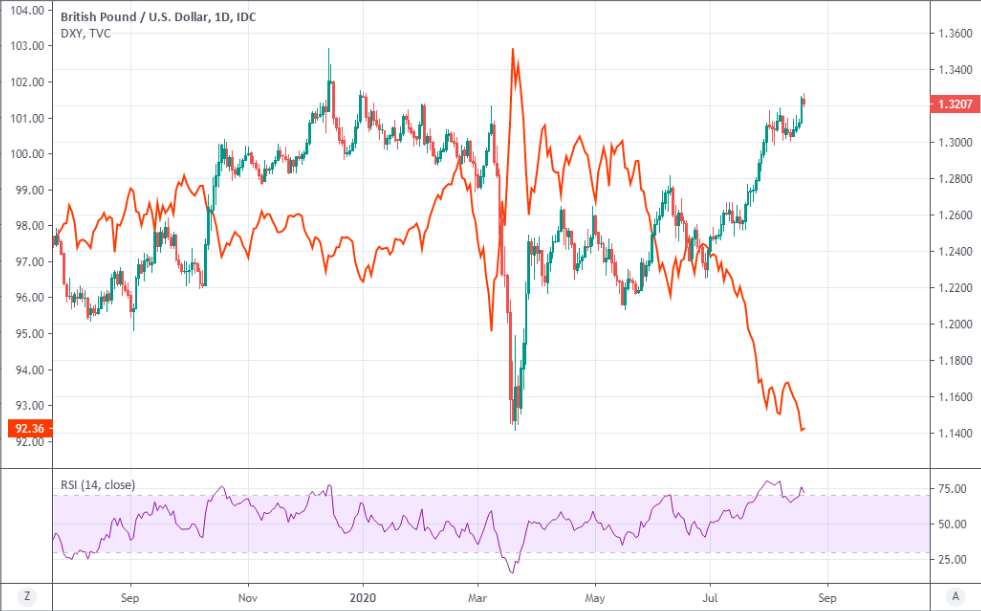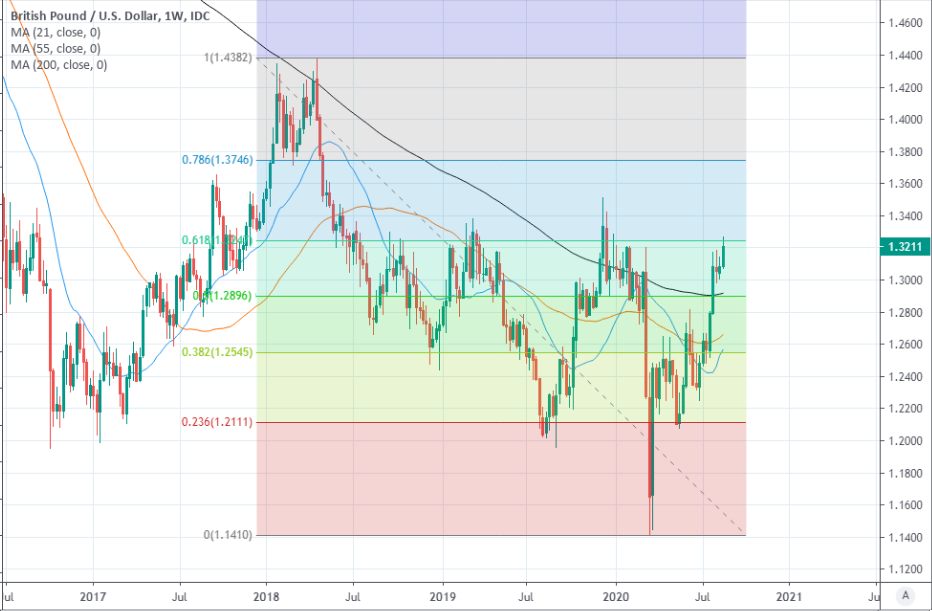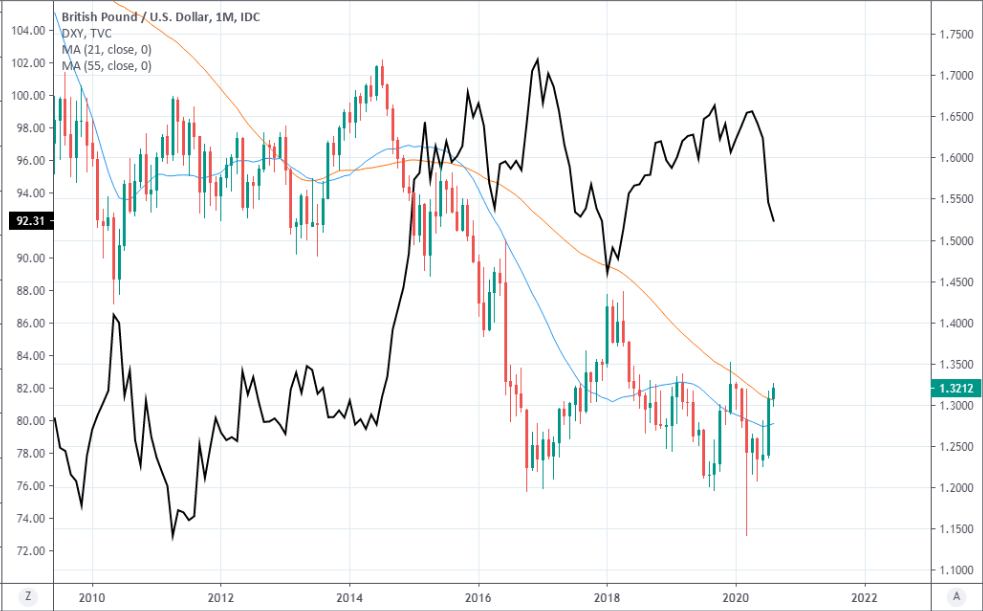Pound-Dollar Rate Slips from 2020 High and "Can't Afford to Vacillate at These Levels" says UOB
- Written by: James Skinner
-

Image © Adobe Images
- GBP/USD spot rate at time of writing: 1.3211
- Bank transfer rate (indicative guide): 1.2849-1.1941
- FX specialist providers (indicative guide): 1.3013-1.3092
- More information on FX specialist rates here
The Pound-to-Dollar rate turned lower from 2020 highs on Wednesday following explosive gains earlier this week but Sterling's indecision risks seeing it come undone, according to strategists at Singapore's UOB Bank, which is a sentiment that's also been echoed by others too.
Pound Sterling was trickling lower against many counterparts with gains over only the underwater Swiss Franc in the major currency complex on Wednesday, in the price action that brought with it a tentative correction of recent trends across the foreign exchange universe.
A Brexit trade deal is still more likely than not, according to anonymous officials cited by the BBC's Katya Adler during the lunch hour, although the revelation did little to improve the fortune of a poorly Pound.
This landed on the wires hours after the FT reported that trade talks are headed for a fresh deadlock earlier in the European session, though Sterling was subsequently found trading higher against most majors amid the morning rush.
Earlier outperformance came after stronger-than-expected inflation numbers offered neither rhyme nor reason for the Pound's climb through the major currency performance rankings, given that few expect the Bank of England (BoE) base rate to do anything other than fall in the next two years or so.
Without the possibility of an interest rate rise, stronger inflation pressures might be a net-negative for currencies when written on paper.
"While the overall technical readings suggest GBP/USD could continue to strengthen, we are mindful about the overbought conditions," says Quek Ser Leang, a strategist at UOB. "Furthermore, there are a couple of rather long-term (and strong) resistance levels that are not far above the current level of 1.3245."
Above: GBP/USD at daily intervals with Dollar Index (orange line, left axis) & relative-strength-index (RSI) measure of momentum (RSI). Divergence between price & RSI amounts to 'bearish divergence,' indicating a faltering trend.
Multiple narratives seek to explain currency market price action but whether it's negative inflation-adjusted bond yields, the supposed death of U.S. Dollar reserve status, a Eurozone outperformance of the U.S. or a simplistic "risk-on, risk-off" market, no narrative has gone completely uncontradicted.
"The marked weakness in the USD yesterday without any prominent catalyst, other than a brief move to a fresh high for the S&P500, suggests risk appetite is the dominant consideration for the USD. But the speed and scale of the move suggests the underlying disdain for the USD remains in place, in a kind of “dollar off” tone. Real yields remain part of the narrative and with nominal yields falling in the last few days, the USD has been vulnerable," says Daragh Maher, head of U.S. FX strategy at HSBC, who forecasts a year-end GBP/USD rate of 1.20.
For Sterling one of the things that can be reliably observed and in the above image is that this week's high wasn't accompanied by a new high for the relative-strength-index on the daily charts, which amounts to what technical analysts would call 'bearish divergence' that signals a dying trend.
In addition, Sterling has failed this week to overcome the 61.8% Fibonacci retracement of its 2018 downtrend, although this was only the first asking. Factors like this are why UOB's Ser Leang and others are concerned about whether Sterling can sustain current lofty heights.
"GBP/USD has not closed above this [55-month] moving average since 2014. This level is followed by the 2018 peak at 1.3516. In order to maintain the current impetus, GBP/USD cannot afford to vacillate at these overbought levels," UOB's Ser Leang warns in a research note Wednesday.
Sterling has advanced above its 55-month moving-average located around 1.2727 in August in moves that came alongside explosive gains by the Euro-to-Dollar rate, which the Pound tends to follow closely.
It has not closed any month above its 55-month average for more than five-years and it isn't just UOB who's less than convinced it'll do so this time.
"Time is running out and promising [Brexit] headlines are needed for sterling to maintain course. For now, the technical break above the 1.3200 area here is in focus and it arguably needs to hold above 1.3150 to stay viable. The weak US dollar is doing most of the lifting here. The next level higher is the massive 1.3500 area, the high since back in early 2018 when the USD was in a rut," says John Hardy, head of FX strategy at Saxo Bank.
Above: GBP/USD at weekly intervals with Fibonacci retracements of 2018 fall and 21 (blue), 55 (orange) & 200-week moving-average (black). Pound Sterling has failed to overcome the 61.8% retracement of its long-term trend on the first asking.
Thursday might be a volatile day for the Pound, Euro and other major currencies given Turkey's central bank will announce its latest policy decision at 11:00 and both positive as well as negative surprises could impact GBP/USD and EUR/USD. Some in the market expect rate hikes to bring to an end in the months ahead, to a long cycle of rate cuts that's reduced the cash rate from 24% in January 2019 to 8.25% in 2020.
This has crushed investors' real, inflation-adjusted returns from Turkish bonds.
"We have been long EURUSD since the 1.1200 level and keep our stop loss at 1.1680 (just below Aug lows)," says Shahab Jalinoos, head of FX strategy at Credit Suisse. "As for EM FX, we advise against excessive generalization and would not look to trade general USD direction by buying “laggards” without a thorough appreciation for the idiosyncratic risks in play in many EM currencies. The likes of TRY and BRL may not be ideal “catch up” expressions."
If the market decides to penalise the Lira for anything Thursday then EUR/USD and USD/TRY will be among the main henchmen involved because an increase in at least one of those is necessary to lift EUR/TRY, and if the Turkish currency is to really be punished, simultaneous increases are necessary.
This could impact GBP/USD because of the relationship with EUR/USD, although the UK is also a large Turkish trade partner and so Sterling exchange rates are also an important part of the Turkish Lira equation.
"Technically, USD is oversold and vulnerable to a relief rally. Momentum indicators are near extremes and speculators have built‑up sizeable net short USD exposure. However, the fundamental USD downtrend is intact underpinned by falling US real yields and US economic underperformance," says Elias Haddad, a strategist at Commonwealth Bank of Australia. "Negotiation on a new US fiscal stimulus package continues in the background but so far there is no breakthrough between Democrats and Republicans. The US Congress is in recess until about mid‑September. Attention today turns to the FOMC."
Above: GBP/USD at monthly intervals with 21 (blue), 55-month moving-averages & Dollar Index (black line, left axis). Rises above 55-month average in August, with 13 days left on the clock to put distance between 1.2727 and market prices.







